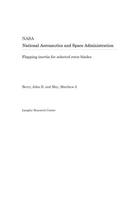
Flapping Inertia for Selected Rotor Blades
Series:
Aerodynamics of helicopter rotor systems cannot be investigated without consideration for the dynamics of the rotor. One of the principal properties of the rotor which affects the rotor dynamics is the inertia of the rotor blade about its root attachment. Previous aerodynamic investigation have been performed on rotor blades with a variety of planforms to determine the performance differences due
NaN
VOLUME
English
Paperback

Aerodynamics of helicopter rotor systems cannot be investigated without consideration for the dynamics of the rotor. One of the principal properties of the rotor which affects the rotor dynamics is the inertia of the rotor blade about its root attachment. Previous aerodynamic investigation have been performed on rotor blades with a variety of planforms to determine the performance differences due to blade planform. The blades tested for this investigation have been tested on the U.S. Army 2 meter rotor test system (2MRTS) in the NASA Langley 14 by 22 foot subsonic tunnel for hover performance. This investigation was intended to provide fundamental information on the flapping inertia of five rotor blades with differing planforms. The inertia of the bare cuff and the cuff with a blade extension were also measured for comparison with the inertia of the blades. Inertia was determined using a swing testing technique, using the period of oscillation to determine the effective flapping inertia. The effect of damping in the swing test was measured and described. A comparison of the flapping inertials for rectangular and tapered planform blades of approximately the same mass showed the tapered blades to have a lower inertia, as expected. Berry, John D. and May, Matthew J. Langley Research Center...
Price Comparison [India]
In This Series
Bestseller Manga
Trending NEWS




















